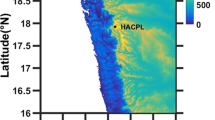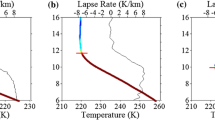Abstract
The mean spatiotemporal variations in tropopause parameters over the tropics (±35°, in latitude) in the Indian monsoon region are examined using the upper air data for an extended period obtained from radiosonde and Radio Occultation measurements. In general, the altitude of cold point tropopause (CPT) is a minimum near the equator and increases with latitude on either side. While CPT over the entire southern tropical latitudes and northern equatorial region is cooler (higher) during boreal winter and warmer (lower) during boreal summer, the annual pattern of CPT-temperature reverses in the northern hemispheric off-equatorial region. The temperature of lapse rate tropopause (LRT) is always negatively correlated with its altitude. While the annual variation of LRT-temperature in tropics is always positively correlated with CPT-temperature, the annual variation of LRT-altitude differs mainly in the off-equatorial regions. While the altitude of the convective tropopause is positively correlated with CPT-altitude over the latitude region 20°S–5°N, they are negatively correlated at the north of 10°N. In general, the tropical tropopause layer (TTL) is very thin (~3 km) near the equator and its thickness increases with latitude on either side of the equator to reach a peak value (of ~6 km) around ±30°. A pronounced decrease in TTL-thickness observed over the northern off-equatorial region during the ASM period can be attributed to the manifestation of very deep convection over the land near the Head Bay-of-Bengal region. The TTL-lapse-rate (γTTL) is large in the equatorial region and decreases with increase in latitude. While γTTL in the northern hemispheric off-equatorial region is low during winter, it increases and becomes comparable to that over equatorial region during the ASM period. The annual variations in CPT parameters as well as the TTL- thickness are significantly modulated by quasi-biennial oscillation and the El Niño Southern Oscillation.








Similar content being viewed by others
References
Angell JK, Korshover J (1964) Quasi-biennial variations in temperature, total ozone, and tropopause height. J Atmos Sci 21:479–492
Angell JK, Korshover J (1974) Quasi-biennial and long-term fluctuations in tropopause pressure and temperature and the relation to stratospheric water vapor content. Mon Weather Rev 102:29–34
Anthes RA, Rocken C, Kuo YH (2000) Applications of COSMIC to meteorology and climate. Terr Atmos Oceanic Sci 11:115–156
Dethof A, O’Neill AO, Slingo JM, Smit HGJ (1999) A mechanism for moistening the lower stratosphere involving the Asian summer monsoon. Quart J Roy Meteor Soc 125:1079–1106
Fueglistaler S, Dessler AE, Dunkerton TJ, Folikins I, Fu Q, Mote PW (2009) Tropical tropopause layer. Rev Geophys 47:Rg1004. doi:10.1029/2008RG000267
Gage KS, Reid GC (1987) Longitudinal variations in tropical tropopause properties in relation to tropical convection and El Nino-Southern Oscillation events. J Geophys Res 92(C13):14197–14203
Gettelman A, Forster PM (2002) Definition and climatology of tropical tropopause layer. J Meteorol Soc Jpn 80(4B):911–924
Hatsushika H, Yamazaki K (2001) Interannaul variations of temperature and vertical motion at the tropical tropopause associated with ENSO. Geophys Res Lett 28(15):2891–2894
Highwood EJ, Hoskins BJ (1998) The tropical tropopause. Q J R Meteorol Soc 124:1579–1604. doi:10.1002/qj.49712454911
Hoerling MP, Schaack TK, Lenzen AJ (1991) Global objective tropopause analysis. Mon Weather Rev 119:1816–1831
Holton JR, Gettelman A (2001) Horizontal transport and the dehydration of the stratosphere. Geophys Res Lett 28(14):2799–2802. doi:10.1029/2001GL013148
Jain AR, Das SS, Mandal TL, Mitra AP (2006) Observations of extremely low temperature over the Indian tropical region during monsoon and post monsoon months: possible implications. J Geophys Res 111:D07106. doi:10.1029/2005JD005850
Kirk-Davidoff DB, Hintsa EJ, Anderson JG, Keith DW (1999) The effect of climate change on ozone depletion through changes in stratospheric water vapour. Nature 402:399–401
Kishore P, Namboothiri SP, Igarashi K, Jiang JH, Ao CO, Romans LJ (2006) Climatological characteristics of the tropopause parameters derived from GPS/CHAMP and GPS/SAC-C measurements. J Geophys Res 111:20110. doi:10.1029/2005JD006827
Krishna Murthy BV, Parameswaran K, Rose KO (1986) Temporal variations of the tropical tropopause characteristics. J Atmos Sci 43:914–923
Kuo YH, Wee TK, Sokolovskiy S, Rocken C, Schreiner W, Hunt D, Anthes RA (2004) Inversion and error estimation of GPS radio occultation data. J Meteorol Soc Jpn 82:507–531
Meenu S, Rajeev K, Parameswaran K, Nair AKM (2010) Regional distribution of deep clouds and cloud top altitudes over the Indian subcontinent and the surrounding oceans. J Geophys Res 115:D05205. doi:10.1029/2009JD011802
Mehta SK, Krishna Murthy BV, Rao DN, Ratnam MV, Parameswaran K, Rajeev K, Suresh Raju C, Rao KG (2008) Identification of tropical convective tropopause and its association with cold point tropopause. J Geophys Res 113:D00B04. doi:10.1029/2007JD009625
Mehta SK, Ratnam MV, Krishna Murthy BV (2010) Variability of the tropical tropopause over Indian monsoon region. J Geophys Res 115:D14120. doi:10.1029/2009JD012655
Melbourne WG, Davis ES, Duncan CB, Hajj GA, Hardy KR, Kursinski ER, Meehan TK, Young LE, Yunck TP (1994) The application of spaceborne GPS to atmospheric limb sounding and global change monitoring. JPL Publ 94–18: p 147, Pasadena, CA
Nash J, Schmidlin FJ (1987) Final report of the WMO international radiosonde intercomparison. WMO Report No. 30, p 123
Nishi N, Nishimoto E, Hayashi H, Shiotani M, Takashima H, Tsuda T (2010) Quasi-stationary temperature structure in the upper troposphere over the tropical Indian Ocean inferred from radio occultation data. J Geophys Res 115:D14112. doi:10.1029/2009JD012857
Norton WA (2001) Longwave heating of the lower stratosphere. Geophys Res Lett 28(19):3653–3656. doi:10.1029/2001GL013379
Pan LL, Randel WJ, Gary BL, Mahoney MJ, Hintsa EJ (2004) Definitions and sharpness of the extratropical tropopause: a trace gas perspective. J Geophys Res 109:D23103. doi:10.1029/2004JD004982
Parameswaran K, Thampi BV, Sunilkumar SV (2010) Latitudinal dependence of the seasonal variation of particulate extinction in the UTLS over the Indian longitude sector during volcanically quiescent period based on lidar and SAGE-II observation. J Atmos Solar Terr Phys 72:1024–1035
Park M, Randel WJ, Gettelman A, Massie ST, Jiang JH (2007) Transport above the Asian summer monsoon anticyclone inferred from Aura Microwave Limb Sounder tracers. J Geophys Res 112:D16309. doi:10.1029/2006JD008294
Randel WJ, Park M (2006) Deep convective influence on the Asian summer monsoon anticyclone and associated tracer variability observed with atmospheric infrared sounder (AIRS). J Geophys Res 111:D12314. doi:10.1029/2005JD006490
Randel WJ, Wu F, Gaffen DJ (2000) Interannual variability of the tropical tropopause derived from radiosonde data and NCEP reanalyses. J Geophys Res 105(D12):15509–15523
Randel WJ, Wu F, Rios WR (2003) Thermal variability of the tropical tropopause region derived from GPS/MET observations. J Geophys Res 108:4024. doi:10.1029/2002JD002595
Randel WJ, Park M, Emmons L, Kinnison D, Bernath P, Walker KA, Boone C, Pumphrey H (2010) Asian monsoon transport of pollution to the stratosphere. Science 328:611–613. doi:10.1126/science.1182274
Ratnam MV, Tsuda T, Shiotani M, Fujiwara M (2005) New characteristics of the tropical tropopause revealed by CHAMP/GPS measurements. SOLA 1:185–188. doi:10.2151/sola.2005-048
Ratnam MV, Tsuda T, Mori S, Kozu T (2006) Modulation of tropopause temperature structure revealed by simultaneous radiosonde and CHAMPGPS measurements. J Meteor Soc Jpn 84(6):989–1003
Reid GC, Gage KS (1981) On the annual variation of height of the tropical tropopause. J Atmos Sci 38:1928–1937
Reid GC, Gage KS (1985) Interannual variations in the height of tropical tropopause. J Geophys Res 90:5629–5635
Reid GC, Gage KS (1996) The tropical tropopause over western Pacific: wave driving, convection, and the annual cycle. J Geophys Res 101:21233–21241
Sasi MN, Ramkumar G, Deepa V, Krishna Murthy BV (2000) Inertia-gravity waves associated with the tropical easterly jet over the Indian subcontinent during the south west monsoon period. Geophys Res Lett 27:3201–3204. doi:10.1029/1999GL011216
Satheesan K, Krishna Murthy BV (2005) A study of tropical tropopause using MST radar. Ann Geophys 23:2441–2448
Schmidlin FJ (1988) WMO international radiosonde intercomparison, phase II, 1985: Wallops Island, Virginia. WMO Report-instruments and observing methods Report No. 29, p 113
Schmidt T, Wickert J, Beyerle G, Reigber C (2004) Tropical tropopause parameters derived from GPS radio occultation measurements with CHAMP. J Geophys Res 109:D13105. doi:10.1029/2004JD004566
Schmidt T, Wickert J, Beyerle G, Heise S (2008) Global tropopause height trends estimated from GPS radio occultation data. Geophys Res Lett 35:L11806. doi:10.1029/2008GL034012
Selkirk HB (1993) The tropopause cold trap in the Australian monsoon during STEP/AMEX 1987. J Geophys Res 98:8591–8610
Shepherd TG (2002) Issues in stratosphere-troposphere coupling. J Meteorol Soc Jpn 80(4B):769–792
Shimizu A, Tsuda T (2000) Variations in tropical tropopause observed with radiosondes in Indonesia. Geophys Res Lett 27:2541–2544
Siedel DJ, Randel WJ (2006) Variability and trends in the global tropopause estimated from the radiosonde data. J Geophys Res 111:D21101. doi:10.1029/2006JD007363
Siedel DJ, Ross RJ, Angell JK, Reid GC (2001) Climatological characteristics of the tropical tropopause as revealed by radiosondes. J Geophys Res 106:7857–7878
Thuburn J, Craig CG (2002) On the temperature structure of the tropical substratosphere. J Geophys Res 107:4017. doi:10.1029/2001JD00048
Tsuda T, Murayama Y, Wiryosumarto H, Harijono SWB, Kato S (1994) Radiosonde observations of equatorial atmosphere dynamics over Indonesia: 1. Equatorial waves and diurnal tides. J Geophys Res 99:10491–10505. doi:10.1029/94JD00355
Wang L, Alexander MJ (2010) Global estimates of gravity wave parameters from GPS radio occultation temperature data. J Geophys Res 115:D21122. doi:10.1029/2010JD013860
Wong S, Wang W-C (2003) Tropical-extratropical connection in interannual variation of the tropopause: comparison between NCEP/NCAR reanalysis and an atmospheric general circulation model simulation. J Geophys Res 108(D2):4043. doi:10.1029/2001JD002016
World Meteorological Organization (1957) Meteorology—a three-dimensional science: second session of the commission for aerology. WMO Bull IV(4):134–138
Acknowledgments
The Radiosonde data obtained from ESRL/NOAA through their web site http://www.esrl.noaa.gov/raobs is gratefully acknowledged. We thank the NPSO, UCAR and CDAAC team for providing COSMIC–RO data through their web site http://cosmicio.cosmic.ucar.edu/cdaac. Long-term monthly mean SST data at Niño3.4 region is obtained from National Weather Service, Climate Prediction Center, NOAA website http://www.cpc.ncep.noaa.gov/data/indices. Dr. K. Parameswaran would like to acknowledge CSIR for providing support under the Emeritus Scientist scheme.
Author information
Authors and Affiliations
Corresponding author
Rights and permissions
About this article
Cite this article
Sunilkumar, S.V., Babu, A. & Parameswaran, K. Mean structure of the tropical tropopause and its variability over the Indian longitude sector. Clim Dyn 40, 1125–1140 (2013). https://doi.org/10.1007/s00382-012-1496-8
Received:
Accepted:
Published:
Issue Date:
DOI: https://doi.org/10.1007/s00382-012-1496-8




